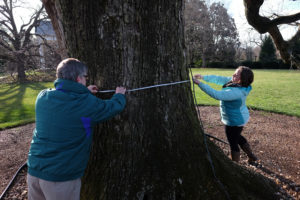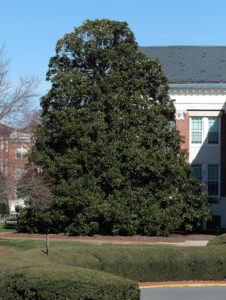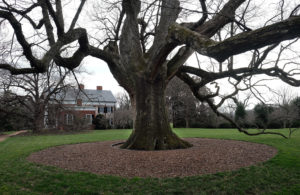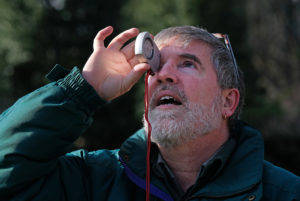Trees. They give us shade, fresh air, flowers and fruits.
On Arbor Day, as the world celebrates the beauty and utility of trees, UMW recognizes nearly 1,000 on the Fredericksburg campus – and the initiative that’s taking stock of them all.

Professor of Biology Alan Griffith and the student volunteers he recruits each semester are mapping every linden and oak, every cedar and dogwood, every single type of tree that sprouts up across campus. The task’s implications are lofty, pinpointing harmful non-native species, supporting student research and contributing to the concepts of conservation, sustainability and urban ecology.
“For me, the beginning to that understanding is simply knowing what’s out there,” Griffith said.
But the project has its practical side, too.
“I would hope using these maps and databases would bring meaning to everyday work and decision-making,” Griffith said. “Putting a map in a manager’s hand should make their job easier because they know where all their resources are.”

Director of Landscape and Grounds Richard Blair agrees. The maps help his team monitor tree health, repair storm damage, ward off pests and more.
“This project will greatly enhance our ability to track individual tree maintenance histories and cost, as well,” Blair said. “This is something the landscape and grounds department has needed for years.”
The initiative got growing three years ago, when former director of grounds Joni Wilson split up the campus in zones. Section by section – with help from Griffith, UMW Philharmonic Director Kevin Bartram and others – she ID’d each tree.
Then, with DBH (diameter at breast height) tapes, clinometers and other tree-measuring tools, their bowls, trunks and canopies, their heights and circumferences, were sized up in centimeters. The data is recorded on smartphones with an app called Collector for ArcGIS, then transferred to online maps that show each plant’s name, family and more.
UMW’s “heritage trees,” the biggest and oldest on campus, were measured first, followed by those at the President’s home, including the famous Brompton Oak with its distinguished Civil War roots. Next, the team tackled the red cedars that line up between the Battleground Athletic Complex and Hanover Avenue, and the zones between William Street and Combs Hall.

By now, Griffith estimates, about half of Mary Washington’s trees have been measured, and he hopes to be finished by summer’s end.
“It’s kind of a painstaking process,” said Griffith, who acknowledges that new trees are spawned every day. “I’ll have a job for the rest of my life.”
With UMW recognized as Tree Campus USA by the Arbor Day Foundation for three consecutive years, the work is worth it, and the project could branch off in different directions to include documentation of shrubs, vines and other plant life. Already, students are tackling the campus’s handful of non-landscaped lots.

“My goal is to help generate awareness about the important part our woodlots play in promoting biodiversity,” said biology major Blake Gostelow, a senior who plans to enroll in UMW’s MSGA program. Along with his assistant, freshman Devin Rantz, Gostelow has mapped and measured invasive species like mimosa and tree-of-heaven in the woods wedged between the Jepson Science Center and Pollard Hall. “I hope it gets people thinking about what we should be doing about invasive species and what we can do to promote our own native wildlife.”
Gostelow planned to present his findings at UMW’s Research and Creativity Day, as did Skyler Larsen, who’s helped with the tree-mapping project for years.
“It gave me leadership, friends, school credits, a capstone project and a great experience,” Larsen said. “One of those alone would be great, but I got them all.”
Learn more about UMW’s tree-mapping project at umwplantcollections.net.